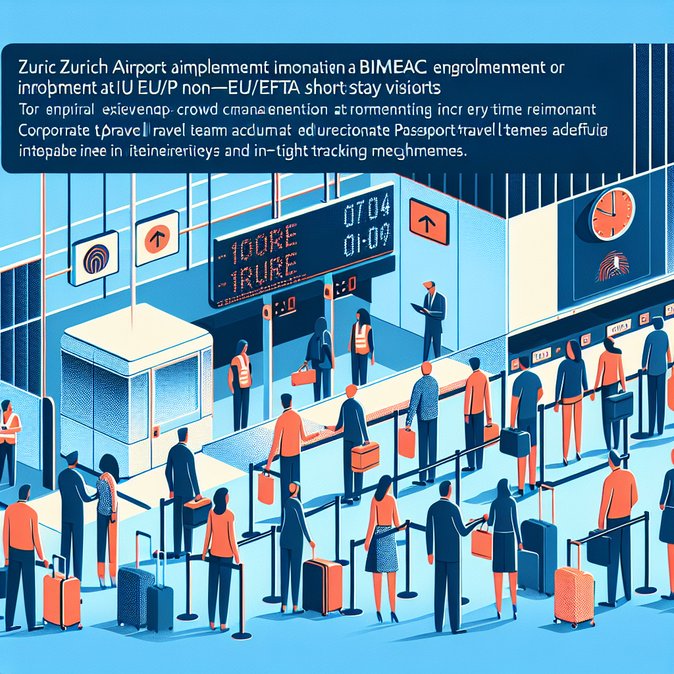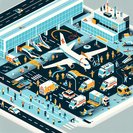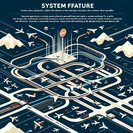
Zurich Airport (ZRH) has become the last major Swiss gateway to activate the European Union’s Entry/Exit System (EES), a move that fundamentally changes how non-EU/EFTA nationals enter and leave Switzerland. From the first long-haul arrivals on 17 November 2025, third-country visitors must complete a one-time biometric enrolment—four fingerprints and a live facial image—at one of 52 self-service kiosks or a staffed desk before proceeding to a border officer. The process, which replaces manual passport stamping, links each traveller’s data to an EU-wide database for three years and automatically calculates their remaining Schengen-area stay under the 90/180-day rule.
Context and background: The EU launched EES on 12 October 2025, giving external Schengen borders a six-month window to phase in the new technology. Switzerland brought Basel–Mulhouse and Geneva on-line on day one; smaller airports will follow before April 2026. Zurich’s late adopter status reflects the airport’s larger infrastructure needs—additional e-gates, dedicated biometric lanes and multilingual signage—to handle heavy long-haul banks at dawn and late afternoon. Zurich Cantonal Police, which runs border control, report that first-time enrolment adds 30-60 minutes at peak, but subsequent trips will be faster once a traveller is “in the system.”
![Zurich Airport Switches On EU Entry/Exit System, Adding Mandatory Biometric Checks for Third-Country Travellers]()
Operational implications: • Business travellers from the United States, UK, India and Gulf states—markets with frequent short-stay project rotations—should build extra buffer time into connections and plan at least 90 minutes for non-Schengen to Schengen transfers while queues stabilise. • Airlines and travel managers are triaging passengers at the gate to steer first-timers toward the correct lanes and avoid missed flights. • HR teams must tighten tracking of employee days in Schengen, as over-stays will now trigger automated alerts to all member states, increasing the risk of fines and future entry bans.
Privacy and compliance: Zurich Airport stresses that biometric data remain under EU regulation, stored for up to three years between visits. Children under 12 are exempt from fingerprinting but must still provide a facial image. Swiss citizens, EU/EFTA nationals and holders of Swiss residence permits continue to use existing e-gates or manual booths and are not registered in EES.
Looking ahead: With the EU planning to introduce the linked ETIAS travel authorisation in 2026, the Zurich roll-out is a critical dress rehearsal. Companies with large numbers of non-EU assignees should update pre-trip checklists, rehearse kiosk flows with arriving staff and audit travel calendars monthly to avoid inadvertent over-stays that will now surface instantly across Schengen.
Context and background: The EU launched EES on 12 October 2025, giving external Schengen borders a six-month window to phase in the new technology. Switzerland brought Basel–Mulhouse and Geneva on-line on day one; smaller airports will follow before April 2026. Zurich’s late adopter status reflects the airport’s larger infrastructure needs—additional e-gates, dedicated biometric lanes and multilingual signage—to handle heavy long-haul banks at dawn and late afternoon. Zurich Cantonal Police, which runs border control, report that first-time enrolment adds 30-60 minutes at peak, but subsequent trips will be faster once a traveller is “in the system.”

Operational implications: • Business travellers from the United States, UK, India and Gulf states—markets with frequent short-stay project rotations—should build extra buffer time into connections and plan at least 90 minutes for non-Schengen to Schengen transfers while queues stabilise. • Airlines and travel managers are triaging passengers at the gate to steer first-timers toward the correct lanes and avoid missed flights. • HR teams must tighten tracking of employee days in Schengen, as over-stays will now trigger automated alerts to all member states, increasing the risk of fines and future entry bans.
Privacy and compliance: Zurich Airport stresses that biometric data remain under EU regulation, stored for up to three years between visits. Children under 12 are exempt from fingerprinting but must still provide a facial image. Swiss citizens, EU/EFTA nationals and holders of Swiss residence permits continue to use existing e-gates or manual booths and are not registered in EES.
Looking ahead: With the EU planning to introduce the linked ETIAS travel authorisation in 2026, the Zurich roll-out is a critical dress rehearsal. Companies with large numbers of non-EU assignees should update pre-trip checklists, rehearse kiosk flows with arriving staff and audit travel calendars monthly to avoid inadvertent over-stays that will now surface instantly across Schengen.








